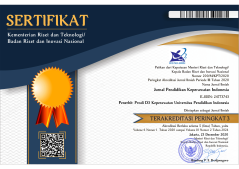The Spiritual Distress of Adolescents "Men Sex Men"(MSM) Infected with HIV in Bandung
Abstract
The prevalence of cases of HIV infection in the group of adolescents “Men Sex Men (MSM) in Indonesia has continued to increase from 2015 to 2019. The problem of decreasing physical health, feeling depressed, social stigma, stress and inconsistent behavior with religious values will create prolonged distress that hinders the quality of life. The purpose of this study was to identify spiritual distress in adolescents infected with HIV with MSM. This study was conducted with a cross-sectional approach to 84 young people living with HIV/AIDS. The sample selection technique used snowball sampling with a Spiritual questionnaire. Data analysis was conducted by using frequency distribution and Lambda test processed using a computer system. The results showed that 56% were in a state of spirituality with no disturbance, 38.1% were in moderate spiritual distress, and 6% were severe spiritual distress. The SSI score mean of respondents was 16.3 ± SD 4.9. There was a correlation between the length of diagnosis and the incidence of spiritual distress with a p-value of 0.000 and a value of r = 0.459. Spiritual distress tended to occur a lot in the early days of being diagnosed with HIV. There was no correlation between age and the incidence of spiritual distress (p = 0.097). This study showed that spiritual care support for adolescents MSM would help overcome existential problems related to HIV.
Keywords
References
Aisyah, P., Widianty, A., & Lusiani, E. (2020). Koping Religius Remaja ODHA di Kota Bandung. Jurnal Pendidikan Keperawatan Indonesia, 6(1), 37–44.
Armiyati, Y., Rahayu, D. A., & Aisah, S. (2015). Manajemen Masalah Psikososiospiritual Pasien HIV/AIDS di Kota Semarang. The 2nd University Research Coloquium, 2015, 548–556.
Carey, L. B., & Hodgson, T. J. (2018). Chaplaincy, spiritual care and moral injury: Considerations regarding screening and treatment. Frontiers in Psychiatry, 9(December), 1-10.
Dewi, I. P., Nurrohmah, & Fikri Rizki Fadlurrahman. (2020). Analisis Pengetahuan Perawat dalam Menentukan Diagnosis Asuhan Keperawatan Spiritual Islami di Rumah Sakit Syariah. Jurnal Ilmiah Keperawatan Indonesia, 4(1), 73–87.
Gall, T. L., Kristjansson, E., Charbonneau, C., & Florack, P. (2009). A longitudinal study on the role of spirituality in response to the diagnosis and treatment of breast cancer. Journal of Behavioral Medicine, 32(2), 174–186.
Latif, I., Fitriyani, D., & Dartiwen. (2018). Faktor Internal Dan Eksternal Yang Mempengaruhi Perilaku Seksual Lelaki Seks Dengan Lelaki (Lsl) Pada Remaja Di Kabupaten Indramayu. Junal Kesehatan Indra Husada, 6(2), 1-7.
Lin, C. Y., Saffari, M., Koenig, H. G., & Pakpour, A. H. (2018). Effects of religiosity and religious coping on medication adherence and quality of life among people with epilepsy. Epilepsy and Behavior, 78, 45–51.
Lyon, M. E., Garvie, P., He, J., Malow, R., McCarter, R., & D’Angelo, L. J. (2014). Spiritual Well-Being Among HIV-Infected Adolescents and Their Families. Journal of Religion and Health, 53(3), 637–653.
Mariany, B. S., Asfriyati, & Sanusi, S. R. (2019). Stigma , depresi , dan kualitas hidup penderita HIV : studi pada komunitas “lelaki seks dengan lelaki” di Pematangsiantar. Berita Kedokteran Masyarakat, 35(4), 139–146.
Pinho, C. M., Gomes, E. T., Trajano, M. de F. C., Cavalcanti, A. T. de A. E., Andrade, M. S., & Valença, M. P. (2017). Impaired religiosity and spiritual distress in people living with HIV/AIDS. Revista Gaucha de Enfermagem, 38(2), 1-7.
Ramdan. (2018). Hubungan Psikososial Remaja dengan Kematangan Remaja Akhir Hingga Dewasa Awal terhadap orientasi seksualnya. FOKUS (Kajian Bimbingan & Konseling dalam Pendidikan), 1(4), 151–158.
Ross, L., McSherry, W., Giske, T., van Leeuwen, R., Schep-Akkerman, A., Koslander, T., Hall, J., Steenfeldt, V. Ø., & Jarvis, P. (2018). Nursing and midwifery students’ perceptions of spirituality, spiritual care, and spiritual care competency: A prospective, longitudinal, correlational European study. Nurse Education Today, 67(August), 64–71.
Roze des Ordons, A. L., Sinuff, T., Stelfox, H. T., Kondejewski, J., & Sinclair, S. (2018). Spiritual Distress Within Inpatient Settings—A Scoping Review of Patients’ and Families’ Experiences. Journal of Pain and Symptom Management, 56(1), 122–145.
Sateemae, S., Abdel-Monem, T., & Sateemae, M. (2015). Religiosity and Social Problems among Muslim Adolescents in Southern Thailand. Journal of Muslim Mental Health, 9(2), 1-24.
Savitri, A. D., & Purwaningtyastuti, P. (2019). Resiliensi pada Remaja yang Terinfeksi HIV/AIDS (ODHA). PHILANTHROPY: Journal of Psychology, 3(2), 137-151.
Schultz, M., Meged-Book, T., Mashiach, T., & Bar-Sela, G. (2017). Distinguishing Between Spiritual Distress, General Distress, Spiritual Well-Being, and Spiritual Pain Among Cancer Patients During Oncology Treatment. Journal of Pain and Symptom Management, 54(1), 66–73.
Shabani J, Hassan SA, Ahmad A, B. M. (2010). Age as moderated influence on the link of spiritual and emotional intelligence with mental health in high school students. J American Sci., 6(11), 394–400.
Xu, J. (2016). Pargament’s Theory of Religious Coping: Implications for Spiritually Sensitive Social Work Practice. British Journal of Social Work, 46(5), 1394–1410.
DOI: https://doi.org/10.17509/jpki.v7i1.30184
Refbacks
- There are currently no refbacks.
Jurnal Pendidikan Keperawatan Indonesia(JPKI) published by Indonesia University of Education. JPKI is licensed under a Creative Commons Attribution-ShareAlike 4.0 International License.
Statcounter
Office :
Nursing Department. FPOK UPI.
229, Dr. Setiabudhi Street. Bandung 40154
West Java , Indonesia
E-mail : jpki@upi.edu

_.png)
_.png)
_.png)











